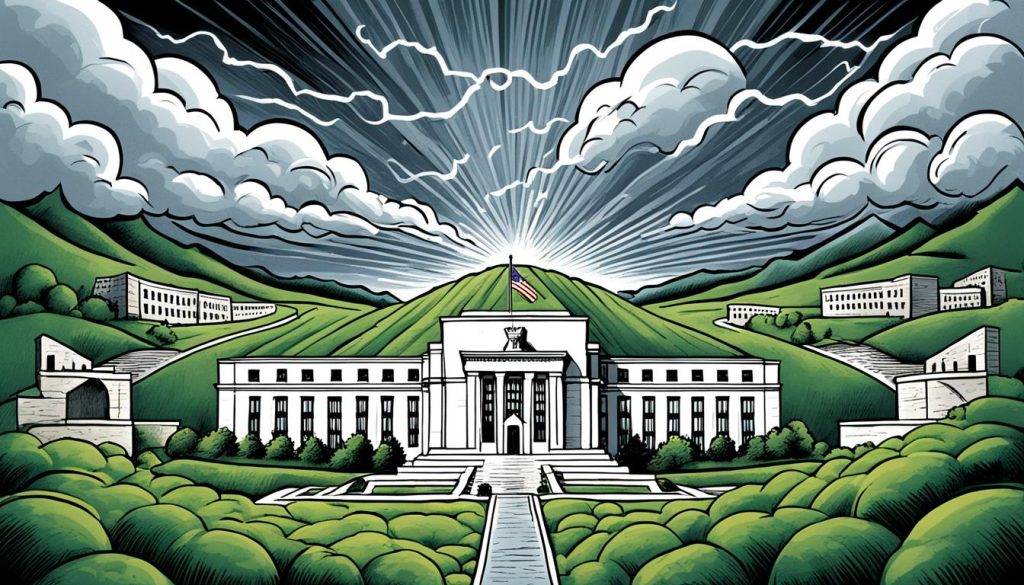The Federal Reserve is the central bank of the United States. It has a huge impact on the country’s finances. It sets interest rates and regulates banks, affecting your money and business. We will explain how the Federal Reserve works and the risks it poses to your financial plans.
The Federal Reserve does more than just set interest rates. In September 2019, it added $75 billion to the market to calm rising interest rates on overnight repos1. During the COVID-19 pandemic, it bought over $1 trillion in securities to help the market1. These actions show how the Fed keeps the economy stable but also bring risks that could affect your investments.
It’s important to know how the Federal Reserve affects your money. This article will go deep into the Fed’s operations and its policies. We’ll also look at the risks that could impact your financial future. By the end, you’ll know how to make smart choices to protect your money.
Key Takeaways
- The Federal Reserve is key in shaping the nation’s finances, affecting interest rates and banking rules.
- The Fed’s actions, like adding money to the market and buying securities, can greatly affect your finances.
- Knowing about the Federal Reserve’s power and risks is crucial for a strong financial plan.
- This article will dive into the Fed’s complex operations and how they might affect your investments.
- By the end, you’ll be ready to make smart choices to safeguard your financial future.
The Federal Reserve: More Than Meets the Eye
The Federal Reserve, also known as the Fed, is a key player in our economy. It’s not just about setting interest rates. After the 2008 financial crisis, the Fed became a key regulator for big banks2.
Separating Fact from Fiction: Demystifying the Fed’s Role
Many people misunderstand the Fed’s role and its effects on our wallets. The Fed’s main goal is not to fight inflation at all costs. Instead, it works to keep prices stable and everyone employed. By managing money supply, the Fed helps balance economic growth and inflation risks2.
Understanding the Fed’s Impact on Your Financial Future
The Fed’s decisions on interest rates and money supply affect your finances. Higher interest rates make borrowing costlier, impacting loans for homes, cars, and credit cards. Lower rates make borrowing cheaper, which can boost spending and investments3.
The Fed does more than just set interest rates. It plays a key role in keeping the financial system stable. This ensures it can handle economic ups and downs2.
Knowing how the Fed works and its impact on your money can help you make smarter choices. This way, you can be ready for any economic changes4.
“The Federal Reserve’s primary objective is to maintain stable prices and full employment, not to control inflation at all costs.”
The Federal Reserve and Your Portfolio: Managing Interest Rate Risk
When the federal reserve changes interest rates, it affects your investment portfolio, especially fixed-income investments. Rising interest rates can lower the value of bonds and other fixed-income securities, threatening your portfolio’s stability5. We’ll look at ways to handle interest rate risk and shield your investments from the federal reserve’s policies6.
Diversifying your portfolio management is a key strategy. Mixing different types of fixed-income securities with various maturities can reduce the effect of rate changes. This includes short-term, intermediate-term, and long-term bonds, and hedging strategies like interest rate swaps and futures contracts6.
Keeping an eye on your portfolio’s duration is also crucial for managing interest rate risk. Duration shows how much a bond’s value changes with interest rates. Adjusting your fixed-income holdings by their duration can match your risk tolerance and goals7.
Investing in floating-rate securities, like adjustable-rate mortgages or floating-rate bonds, is another smart move. These investments usually do well when interest rates go up, since their yields change with the rates6.
Managing interest rate risk in your portfolio needs a proactive and varied approach. Using these strategies helps you deal with the federal reserve’s rate changes and protect your investments for the long term6.
“The Federal Reserve’s decisions on interest rates can have a profound impact on the performance of your investment portfolio. By understanding and managing this risk, you can help ensure the long-term resilience of your financial assets.”
Navigating Duration Drift: The Hidden Threat to Fixed-Income Investments
If you invest in bonds, you know about “duration risk.” This is how your bond portfolio’s value changes with interest rates. But, there’s another challenge: “duration drift.” This is when your bonds’ durations don’t match your hedging tools like options and swaps8.
The Diminishing Options and Swaps Market: A New Reality
The options and swaps markets have changed, making it harder to find contracts that match your portfolio. This leaves you open to interest rate risk. Now, fixed-income managers are looking at the futures market for new ways to manage risk8.
Futures as the New Frontier: Adapting to Market Shifts
Using the futures market to hedge your bonds brings new challenges and chances. Futures can help manage risk but also bring new issues like managing margins and basis risk. It’s important to understand these to adapt your strategies for the changing market8.
To tackle duration drift, investors are trying different strategies. These include:
- Building portfolios with short-term and medium-term bonds to match their hedging tools8
- Using a mix of options, swaps, and futures to manage interest rate risk8
- Keeping an eye on and adjusting their hedging as market conditions change8
By staying informed and flexible, investors can handle duration drift. This keeps their portfolios strong through market changes8.
“The key to managing duration risk in a fixed-income portfolio is to maintain a keen understanding of the market landscape and be proactive in adjusting your hedging strategies as needed.”

The financial world keeps changing, so investors must stay alert and try new strategies for duration drift. This way, you can keep your portfolio stable and strong8.
For those wanting to learn more about the fixed-income market, check out Dr. Perry Mehrling‘s work. He’s a top expert in Monetary Theory and Financial Economics9. His insights and research offer great advice on navigating today’s financial system9.
Basis Trades and Market Stability: Hedge Funds in the Spotlight
Hedge funds are now under more watchful eyes for their “basis trades”. These trades involve borrowing from the repo market to buy Treasury securities and then selling Treasury futures. This has raised concerns among regulators10. Between October 4th, 2022, and May 9th, 2023, hedge funds increased their repo borrowing by $120 billion10. They also boosted their short futures positions in the 2-year, 5-year, and 10-year contracts by $411 billion10.
Leveraged Arbitrage: Friend or Foe?
These leveraged arbitrage strategies aim to fix price differences but can also make markets unstable by taking liquidity during stress times10. Regulators fear that hedge funds’ high leverage could cause quick sell-offs and “fire sales”, destabilizing the market11. Yet, today’s financial intermediaries’ exposure to hedge funds is likely more spread out than in 199811. Also, the average leverage in hedge funds and the highly leveraged ones is thought to be lower now than back then11.
To tackle these worries, regulators are pushing for more transparency and keeping an eye on hedge funds in the Treasury and repo markets11. But, making hedge funds open up more has been tough, as it could cut into their profits11.
| Metric | 2022 | 2023 |
|---|---|---|
| Sponsored repo borrowing by hedge funds | $114 billion | $233 billion10 |
| Sponsored lending by hedge funds | $31 billion | $39 billion10 |
| Borrowing against deliverables in DVP sponsored repo | $19 billion | $39 billion10 |
Even with hedge funds’ growing presence in the Treasury and repo markets, the financial system seems more stable now than before11. Still, regulators are closely watching how hedge fund strategies affect market stability and liquidity10.

“The actions of hedge funds, particularly their use of ‘basis trades’, have come under increased scrutiny from regulators due to concerns about market stability and liquidity.”
Beyond Funds: Rethinking Market Structure for Financial Stability
The focus has often been on investment funds, but the real issue is in the fixed-income hedging markets12. There’s a lack of options and swaps that match the length of fixed-income assets. This has made fund managers turn to the futures market12. This change has made markets more volatile and unstable12.
The Root Cause: Inefficiencies in Hedging Markets
Regulators must look deeper to fix these issues. They need to tackle the inefficiencies in the hedging markets12 that cause these problems. Creating tools to measure these inefficiencies could help make the financial system12 more stable.
| Metric | Value | Comparison |
|---|---|---|
| US Output Level | 13% below pre-crisis trend | Strong indicator of the impact of the global financial crisis13 |
| Output Losses in UK | Around 16% of pre-crisis GDP | Exceeding those experienced in the US and even surpassing the Great Depression era13 |
| Government Debt Increase (Post-Great Depression) | Around 28 percentage points | In the decade following the Great Depression in the US13 |
| Government Debt Increase (Post-Great Recession) | Around 28 percentage points | For countries like the US, UK, France, and Germany since the Great Recession13 |
| Basel III Core Capital Requirement | 4.5% | Up from 2% under Basel II13 |
This table shows the big economic and regulatory effects of the global financial crisis. It highlights the need for a big change in the financial market structure12 for stability and resilience.
“To truly address these challenges, regulators need to look beyond the actions of individual funds and address the root cause – the inefficiencies in the hedging markets that are driving these behavioral changes.”
By focusing on structural inefficiencies in the hedging markets12, policymakers can work towards a better approach to fixed-income risk management12 and systemic risk12 mitigation. This could lead to a more stable and resilient financial system1213.
Unlocking the Federal Reserve’s Potential: Transparency and Innovation
The Federal Reserve is key to keeping the economy stable. It has a big role in shaping the future of finance. To do this, the Fed needs to be more open and use new ideas to tackle market challenges14.
In 2019, the Federal Reserve talked about using new data in credit checks. This helps people who couldn’t get loans before14. Then, in 2020, they set rules for small loans that use new data, helping more people get credit14. This is important for people who need quick cash and don’t have good credit14.
The Fed can do better by talking more, working with experts, and trying new things. This helps spot and fix risks, making finance safer and more stable15. For example, the Fed’s instant payments plan makes moving money fast and safe, anytime16.
The financial world is always changing. The Federal Reserve must keep up with innovation and financial regulation to keep the system stable. By being open and using new ideas, the Fed can make finance safer and easier for everyone1516.,
“The Federal Reserve must remain at the forefront of innovation and financial regulation to ensure the stability of the overall financial system.”
| Initiative | Benefit |
|---|---|
| Alternative Data in Credit Underwriting | Expanded access to credit for traditionally excluded borrowers |
| Responsible Small-Dollar Lending | Meeting short-term liquidity needs and enhancing credit access |
| Instant Payments | Faster, more secure transactions and cost savings for customers and institutions |
Conclusion: Embracing Change for a Resilient Financial Ecosystem
The federal reserve is dealing with complex monetary policy issues. It’s important for you to know about the risks and changes in financial markets. With inflation high and the Fed raising interest rates, sectors like housing and investments feel the effects17. But, the banking sector is strong, thanks to strict rules and tests, helping them handle stress well17.
The move to digital finance brings both chances and challenges. These include competition, regulatory perimeters, and how markets work18. Big tech companies in finance use big data, showing the need for good risk management and watching over systemic risk18. As finance changes, being open, innovative, and having a full view of the system is key to a strong and prosperous future.
Keep up with the Federal Reserve’s moves, understand changes in financial markets, and work with regulators and others in the industry. This way, you can make a financial plan that can handle future challenges19. The road ahead may have hurdles, but by welcoming change and building a secure financial world, you can succeed in the changing finance landscape.
FAQ
What is the role of the Federal Reserve in the U.S. financial system?
The Federal Reserve is the central bank of the U.S. It keeps the economy stable. It sets interest rates, regulates banks, and oversees big financial institutions.
How can the Federal Reserve’s decisions on interest rates impact my investment portfolio?
The Federal Reserve’s interest rate decisions affect your investments, especially bonds. When rates go up, bond values often fall. This can make your portfolio less stable.
What is the issue of “duration drift” and how can it affect my fixed-income investments?
“Duration drift” means your investments and risk management tools don’t match. This mismatch can leave you open to risks from changing interest rates. It’s a challenge for investors in fixed-income assets.
What is the concern around hedge funds’ use of “basis trades” and how can it impact market stability?
Hedge funds use “basis trades” to profit from market differences. But, this can also make markets unstable by taking away liquidity when it’s needed most. Regulators are watching these activities closely.
What is the root cause of the challenges in the fixed-income hedging markets?
The problem is changes in the fixed-income markets. There are fewer options and swaps that match the duration of your investments. This forces fund managers to use futures more, making markets more volatile.
How can the Federal Reserve improve its ability to identify and mitigate emerging risks in the financial system?
The Federal Reserve needs to be more open and innovative. Better communication and working with experts can help it spot and fix risks. This makes the financial system stronger and more stable.
Source Links
- A Safe Haven for Hidden Risks | Elham Saeidinezhad
- Speech by Governor Bowman on perspectives on U.S. monetary policy and bank capital reform
- Federal Reserve Focuses Monetary Policy on Fighting Inflation | U.S. Bank
- There’s both more and less US inflation than meets the eye – Asia Times
- Supervision of SVBFG by Critical Risk Areas
- Impact of Federal Reserve Interest Rate Changes
- Supervisory Developments
- Now’s a Great Time to Build a Bond Ladder
- Love Thinking about Finance, Monetary Economics, and Money View
- Recent Developments in Hedge Funds’ Treasury Futures and Repo Positions: is the Basis Trade “Back”?
- Hedge Funds and Their Implications for the Financial System
- Andrew G Haldane: Rethinking financial stability
- Speech by Vice Chair for Supervision Barr on financial inclusion
- Unlocking Our Potential
- Unlocking the Potential of Instant Payments: The Federal Reserve’s New Infrastructure
- Speech by Chair Powell on financial stability and economic developments
- Fintech and the digital transformation of financial services: implications for market structure and public policy

